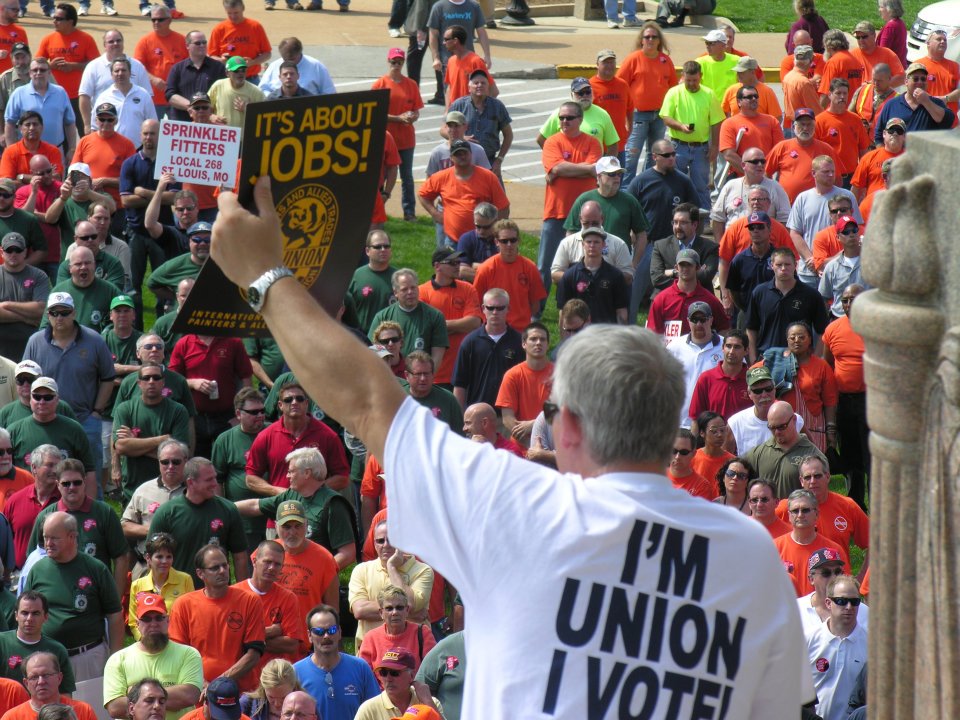August 30, 2016 – In the new report, Union decline lowers wages of nonunion workers: The overlooked reason why wages are stuck and inequality is growing, Washington University sociologist Jake Rosenfeld and co-authors find that the dramatic decline in union density since 1979 has resulted in far lower wages for nonunion workers, an impact larger than the 5 percent effect of globalization on their wages found in recent research.
Specifically, nonunion men lacking a college degree would have earned 8%, or $3,016 annually, more in 2013 if unions had remained as strong as they were in 1979.

Between 1979 and 2013, the share of private sector workers in a union has fallen from about 34 percent to 11 percent among men, and from 16 percent to 6 percent among women. The authors note that unions keep wages high for nonunion workers for several reasons: union agreements set wage standards and a strong union presence prompts managers to keep wages high in order to prevent workers from organizing or their employees from leaving. Moreover, unions set industry-wide norms, influencing what is seen as a “moral economy,”
“Working class men have felt the decline in unionization the hardest,” said Rosenfeld. “Their paychecks are noticeably smaller than if unions had remained as strong as they were almost 40 years ago. Rebuilding collective bargaining is one of the tools we have to reinvigorate wage growth, for low and middle-wage workers.”
Rosenfeld, along with co-authors Jennifer Laird and Patrick Denice, find that the effects of union decline on the wages of nonunion women are not as substantial because women were not as heavily represented in unionized private sector jobs. The authors note, however, that any substantial growth in collective bargaining would be expected to have as much or more impact on women as men. Specifically, the authors find that women’s wages would be 2 to 3 percent higher if unions had stayed at their 1979 levels. Their study also reveals that private sector nonunion men of all education levels would earn 5 percent ($52) higher weekly wages in 2013 if private-sector union density (the share of workers in similar industries and regions who are union members) remained at its 1979 level, an increase of $2,704 in annual paychecks for full-time employees.
This is the first study providing a broad estimate of the wage decline for nonunion workers as the result of the erosion of unions.
This decline in unions has eroded wages for nonunion workers at every level of education and experience, costing billions in lost wages. For the 32.9 million full-time nonunion private sector women and 40.2 million full-time private sector men, there is a $133 billion loss in annual wages because of weakened unions.
Given dramatically weakened unions, their effect on nonunion wages has declined over time: these effects have fallen to between one-half and two-thirds of their late-1970s levels.
Union decline has exacerbated wage inequality in the United States by dampening the pay of nonunion workers as well as by eroding the share of workers directly benefiting from unionization: union erosion can explain a third of the growth of wage inequality among men and one-fifth of the rise of wage inequality among women. At least for middle-wage men, the impact of the erosion of unions on the wages of both union and nonunion workers is likely the largest single factor underlying wage stagnation and wage inequality.
“Unions have functioned to raise the wages of all workers, union and nonunion,” said Lawrence Mishel, EPI President. “The erosion of collective bargaining has clearly taken a huge toll on nonunion wages in the United States, and is a major factor in the wage stagnation of the last four decades.”
but the 4 postal company unions run by thugs get to game the system by the old postal game of divide and conquer…….and line their pockets with cold hard cash……..while the worker gets 1% and a 1 penny per hour UNCOLA………..people waking up, that is why you will see Trump in a landslide!
Vote for Donald Trump the next U.S. President and he will bring back ALL the manufacturing jobs from Mexico and China. This is as likely,as the U.S. labor unions,making a come back,under Hillary Clinton. Actually,the percentage of American workers represented by the UNIONS,peaked back in 1950s.
Just notice how prosperous America is now that many workers earn so much less with unions so weak! The Ratpublicans and Mr. Bankruptcy President want to be desire to hoard all the wealth, with none going to the low workers. A low life worker should earn just enough to stay healthy so they can work hard to make lots of money for the business bastards! The meek will inherit nothing. Fight back, organize!
I wish that the facts were that cut, and dried as it should be. There is not a problem
paying for something . The problem is that that has not happened for 30 years. where
has this happened at the the big three, Government, or Postal system. I would
commend some unions for really trying, but the powers to be like it the way it is.
a lot of talk, and way short on action.
They seem to have totally ignored the Blowbama effect on wages over the past seven/eight years. Since he has been in office, the average household income has declined be thousands per year. Add to that the vastly greater health care expense with Blowbama care.
We now wait for the brain dead trolls to rip this article and unions.
Facts don’t matter to them.
GO UNIONS!
It’s already privatized!